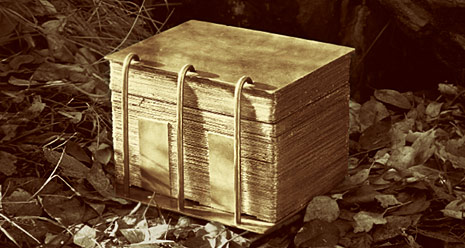“The Book of Mormon: From Plates to Press,” New Era, Sept. 2012, 16–18
The Book of Mormon: From Plates to Press

Photographs by John Luke
During the next year in seminary, you’ll be studying the Book of Mormon. You’ve probably studied it before in church or at home. But have you thought much about how it went from a stack of gold plates to the book sitting on your bedside table? Here are some interesting facts about the receiving, translating, and printing of the Book of Mormon.
The First Vision
-
Joseph Smith’s prayer in the Sacred Grove was the first time he tried to pray vocally (see Joseph Smith—History 1:14).
-
After the First Vision, Joseph looked physically drained. When he got home, his mother asked what was wrong. (See JS—H 1:20.)
-
Joseph Smith’s father, Joseph Sr., had several profound dreams throughout his life. These experiences may help explain why Joseph Sr. so readily accepted his son’s visions and prophetic calling. (See Church History in the Fulness of Times [2003], 22.)
-
How would you respond if your brother said he’d seen a vision? Joseph’s family immediately believed him. His brother William said, “We all had the most implicit confidence in what he said. He was a truthful boy” (quoted in Church History in the Fulness of Times, 34).
The Plates
-
The first time Moroni visited Joseph and told him about the Book of Mormon, he visited him four times, repeating himself and then giving additional information with each successive visit (see JS—H 1:30–49).
-
Moroni visited Joseph every year from 1823 to 1827. In these visits, Moroni taught Joseph about many prophesies and covenants. Moroni and other heavenly messengers helped prepare Joseph for his responsibilities as the Prophet of this dispensation (see History of the Church 4:537).
-
Joseph was 17 when he first saw the gold plates, but he wasn’t allowed to remove them from the hill until four years later (see JS—H 1:50–54).
-
The box with the gold plates also contained the Urim and Thummim and the breastplate (see JS—H 1:52). These are the only objects we know were in the box when Joseph retrieved the plates, though an angel also showed the sword of Laban and the Liahona to the Three Witnesses (see D&C 17:1).
-
The plates Joseph received were written on directly by 11 different people: Nephi, Jacob, Enos, Jarom, Omni, Amaron, Chemish, Abinadom, Amaleki, Mormon, and Moroni. (Of course, the words of other prophets and leaders were recorded on the plates by these 11.) There were also 11 people (besides Joseph Smith) who saw the gold plates and witnessed that they had seen them (see “The Testimony of Three Witnesses” and “The Testimony of Eight Witnesses” near the front of the Book of Mormon).
-
Many people tried to steal the plates once Joseph removed them from the Hill Cumorah. At different times, Joseph hid them in a hollow log, under the hearthstone of his fireplace, under a wood floor on the Smith farm, under flax in a loft, and in a barrel of beans. (See Church History in the Fulness of Times, 44–45.)
The Translation
-
Joseph first began translating the plates in 1827, when he was 21. The majority of the Book of Mormon (531 pages in English) was translated with Oliver Cowdery as scribe in about 65 working days between April and June 1829. (See Church History in the Fulness of Times, 46–62.)
-
The large plates (Mosiah through Moroni) were translated before the small plates (1 Nephi through the Words of Mormon) (see Church History in the Fulness of Times, 59).
-
Martin Harris, Oliver Cowdery, John Whitmer, and Emma Smith served as Joseph’s scribes during the translation of the Book of Mormon (see Church History in the Fulness of Times, 47, 52, 56, 58, and 82). Oliver Cowdery also desired to translate the plates but was unsuccessful (see D&C 8, 9).
-
The first 116 pages of the Book of Mormon, taken from the book of Lehi (part of the large plates of Nephi), were translated soon after Joseph received the plates. Emma Smith and Martin Harris were Joseph’s scribes during this time. These pages were lost and never retranslated. Why? Because wicked men had stolen the pages and altered them, hoping to discredit Joseph when he translated them again and the two manuscripts didn’t match because of their alterations (see D&C 10).
-
The lost 116 pages held the secular history of the Nephites, but Nephi had been asked to prepare two plates that covered the same period of time. We still have the sacred history of the Nephites that was recorded on the small plates. (See 1 Nephi 6, 9; Words of Mormon 1:3–7.)
The Printing
-
Joseph was ready to print the Book of Mormon in 1829. A copyright was obtained on June 11, and the translation was completed on July 1 (see Church History in the Fulness of Times, 66).
-
The printer, E. B. Grandin, was only 23 years old. He agreed to print 5,000 copies of the book, which was an enormous number at that time (see Church History in the Fulness of Times, 63).
-
Martin Harris sold 151 acres of his farm in order to pay the costs of printing the Book of Mormon (see Church History in the Fulness of Times, 65).
-
The Book of Mormon was available for purchase on March 26, 1830. It was bound in brown leather and could be found at Grandin’s bookstore.
-
The cover page of the Book of Mormon was written by Moroni. It says the purpose of the Book of Mormon is to convince “Jew and Gentile that Jesus is the Christ, the Eternal God.”
Joseph Smith’s First Vision by Avard Fairbanks
Joseph Smith Translating the Book of Mormon, by Del Parson